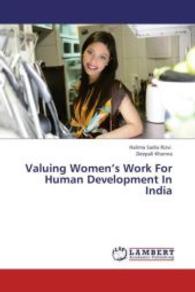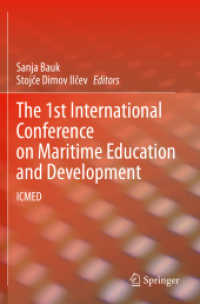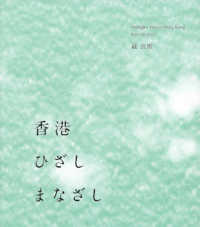- ホーム
- > 洋書
- > ドイツ書
- > Social Sciences, Jurisprudence & Economy
- > Education Science / Pedagogic
- > general surveys & lexicons
Full Description
Science, technology, engineering, and mathematics (STEM) education are seen by leaders from across the globe as key to economic success and prosperity. The goal of Best Practices in STEM Education: Innovative Approaches from Einstein Fellow Alumni, Second Edition is to improve the state of STEM education, not only in the United States, but internationally as well—good education anywhere is good for education everywhere. As the body of STEM-learning research grows, this second volume provides the unique perspective of nationally recognized educators who have spent, collectively, more than 600,000 hours at the interface between teaching and learning. The 24 chapters included in this volume are the product of years of practice, mistakes, reflection, and refinement. They provide the experiential pragmatism backed by research so desired by practitioners. Each chapter communicates how its author has implemented a specific STEM practice in the classroom and how the practice might be modified for use in other classrooms, schools, and learning environments. These are stories of success, as well as stories of struggle. Readers of this second edition will gain powerful insight about what really works when it comes to teaching and learning STEM.
Best Practices in STEM Education: Innovative Approaches from Einstein Fellow Alumni, Second Edition will serve as an excellent resource for use in any science, technology, engineering, and mathematics teaching methods course, and no professional education library, K through college, should be without a copy
Contents
List of Figures, Photos, and Tables - Acknowledgments - Kent H. Hughes: Foreword - Introduction - About the Authors - Nancy Spillane: The Search for Interdisciplinarity: Moving from Biology, Chemistry, and Physics to STEM and Beyond - Carmelina O. Livingston: Building a Foundation for Successful STEM Education at the Elementary Level - Terrie Rust: Engaging Girls in STEM Careers - Brenda Gardunia: Teaching Mathematics to At-Risk Students - Eduardo Guevara: The Student-Centered Sheltered Instructional Approach and Growth (SSIAG) Model - Tim Spuck: Putting the "Authenticity" into Science Learning - Arundhati Jayarao: Engaging Young Minds to be Tomorrow's Innovators - Jean Pennycook: Expand the Horizons of Your Students by Expanding Yours - Sue Whitsett: Research Experiences for Teachers Can Enhance the Teaching of Science - Leigh Jenkins: Modeling Sustainability Through STEM Service-Learning - Dave Oberbillig: Outdoor Ecological Inquiry Brings Students and Nature Together - Dan Carpenter/Florentia Spires/Joseph Isaac: Twenty First Century Skills Inspired Through Global STEM Projects - Remy Dou: Alternative Reality: Gamifying Your Classroom - Buffy Cushman-Patz: Using Whiteboards to Create a Student-Centered, Collaborative Classroom - Bernadine Okoro: Communicating Science to Public Audiences Through Media in High School: Improving Students' Attitudes and Motivations in Science - Jenay Sharp Leach: Discourse Strategies for English Learners in the STEM Classroom - April Lanotte: Increasing Literacy Skills in the STEM Classroom - Paulo A. Oemig: Promoting Science Literate Identities Through the Use of Trade Books - John F. Smith/June Teisan: Building Community Partnerships and Integrating Arts and Social Studies to Strengthen STEM Learning - Melissa George: Zoology Brüt: Using Backward Design to Explore the Sixth Extinction Through Art, Architecture and Appetite - Erin Peters-Burton: Using Self-Regulated Learning Processes to Support Scientific Thinking - Rebecca Vieyra: Teaching Students Metacognition Through Discipline-Based Research and Technology - John D. Moore: Applications of Satellite Imagery, Remote Sensing, and Computer Visualizations: Observing the Earth and Visualizing the Future - Remy Dou/Terrie Rust: Integrating Informal STEM Learning Into Your Curriculum - Index.








